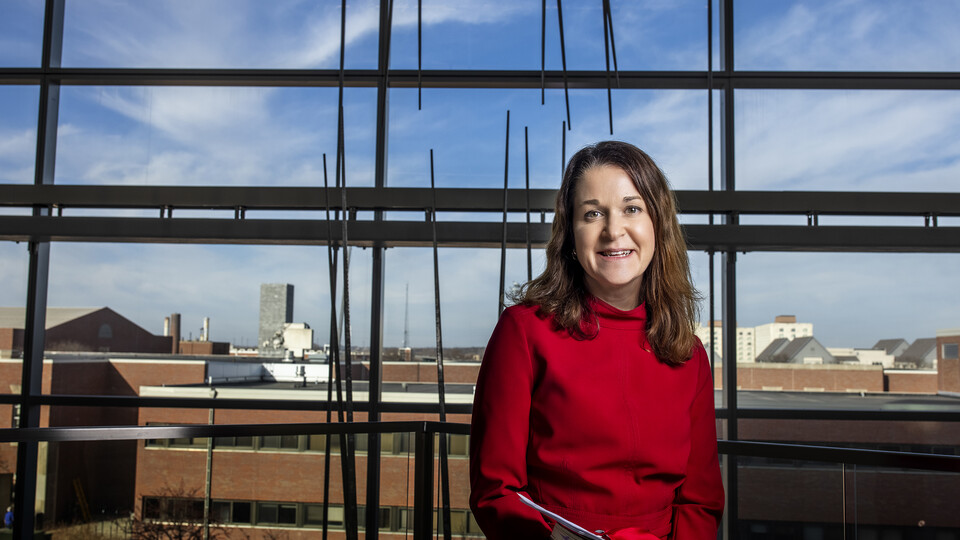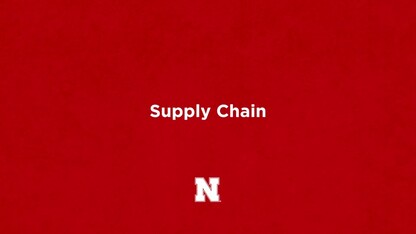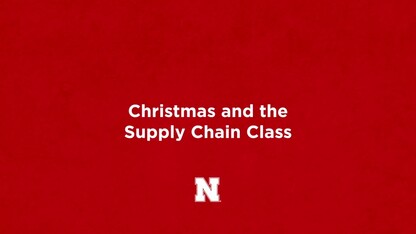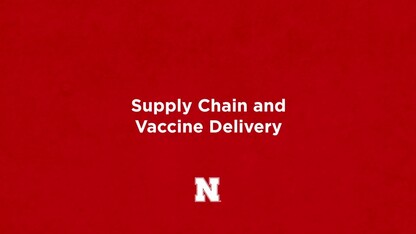· 11 min read
Supply chain stressed but not broken by pandemic

An expert in supply chain management, Shawntell Kroese’s field has never been more top of mind to consumers — or students.
Now an assistant professor of practice in supply chain management and analytics in the College of Business, Kroese’s two decades of experience with Union Pacific logistics has offered students a real-world perspective into the importance of the supply chain and the many obstacles it’s faced during a global pandemic.
Kroese is currently teaching a three-week course, Christmas and the Supply Chain, and she sat down with Nebraska Today for a conversation about how COVID-19 has affected the supply chain, how Christmas will be different this year, and what we can expect from supply chains in the future.
How did you come to be a faculty member at the university, after previously being in the private sector?
After graduation, I started working in Omaha for Union Pacific, a Fortune 150 supply chain transportation company. I was there for 23 years, but I was still very involved with the university and had a love for it. I worked with Rob Simon, associate professor in the College of Business, and we created the Union Pacific class, which is over a dozen years old now. I also had the opportunity to be on several College of Business boards. I knew I wanted to be more involved.
As luck would have it, I called the dean and asked what it would take to be involved at a bigger level and had the opportunity to be an adjunct professor in the summer and teach a supply chain class. I loved it. And then, timing just was on my side. A search committee was put in place for a supply chain professor. The stars aligned in terms of giving me that opportunity.
Supply chain management is usually something we take for granted unless there is an interruption, like we’ve seen recently. What is something that most people don’t really understand about how our consumables get from raw material to store shelves or in the packages on our front porch?
Even my own mother, who I love very much, when the pandemic started happening, she called me and said, ‘Shawntell, I didn’t realize how big a deal what you’ve been doing all these years is.’ For the most part, a normal supply chain is behind the scenes — you never have to think about it. You just sort of take it for granted that the paper towels and toilet paper are going to be on the shelf, that meat is going to be plentiful — all things that we’ve seen in shortage during the pandemic.
When you think about the whole journey of anything, it starts with a lot of decisions made, in terms of quantities, or how much is forecasted to be needed. When you have something like a pandemic, it’s very hard to react quickly. There are a lot of different organizations that have made a conscious decision to have a more ‘just in time’ inventory approach, which also makes it much more difficult to react when suddenly supply chains are shut down or you’re unable to get things from overseas. In terms of that reaction time and that safety stock, if you will, you could never forecast for what we experienced in the spring.
Also, in terms of some products, in terms of the manufacturing and the raw materials, we get those from all around the world. As we started seeing this happening, there were great impacts to us. I think people got smarter in terms of ‘why is it that I can’t get these things that are very commonplace?’ Now, suddenly, I’m realizing it’s not just a U.S. problem. It’s also about our reliance globally.
You talked about forecasting and inventories. What do you think was happening behind the scenes when store shelves were empty? Is there a way to compensate when an emergency like that happens?
It really is product-by-product dependent. With something very familiar, like toilet paper or paper towels, typically those manufacturers have a set amount of space, a set amount of manufacturing capacity. It’s not as simple as just making more. They don’t have the physical capacity to be able to do it. What you saw happening, instead of them packaging 16-packs, for instance, you could only find two-packs, because their mindset changed from giving lots and lots of options to consumers to now trying to give everyone some, and this is how they’ll be able to do it with a relatively fixed capacity.
Food would be another good example. When restaurants closed, which made up roughly half of their demand, suddenly, they’re transitioning to say, ‘what do I need to do differently in the supply chain? There’s now a way bigger demand for individual households, there’s less demand for restaurants. How do I adapt in terms of what I give to grocery stores versus what I’m giving to large purchasing restaurants?’ Everybody has had to adapt and change in terms of how they think through their end markets.
Also, as a consumer, we’ve had to be a little bit more patient. The supply chain is a little bit longer right now. Everyone in the supply chain has had to adapt and kind of manage their expectations in terms of what do I really need in terms of availability and delivery time. I think that’s changed for sure.
You’re teaching the Christmas and the Supply Chain class over the three-week session. What will you be covering in that course and where did the idea come from?
A lot of my passion in teaching is to help bring that perspective to students in terms of how being in the supply chain space matters. I feel very passionately about it. I’m super grateful to this community because it allows me to be creative and create new classes.
In the summer, I offered a five-week session all around supply chain in the pandemic, and it received positive reviews from students. I think the students really enjoyed it. Each week, we talked about something that they were living through. The first week, we studied toilet paper, and we learned how toilet paper was made and why it wasn’t on the shelves. We studied all kinds of those hot topics that we were experiencing.
For Christmas and the Supply Chain, I want to do the same thing. It couldn’t be more perfect in terms of the timing. For students, they’re living it. They see it around them. If they pick up a newspaper or go online, they’re going to see things that are very current and topical, in terms of what we study.
In the class, we’re going to study the manufacturing. Many of the season’s hot toys and what inventory these retailers purchased — those decisions have been made. They’ve bet on what will sell and what will be the hot items. We’ll talk about how long ago they had to forecast and what that looked like. We’ll talk about the transportation piece. This is a very difficult surge period for transportation companies, particularly when you think about Amazon and the two-day demands of getting to the consumer so fast. Then we’ll also talk about the stores and the consumer experience. I like to say that people in the supply chain space, they’re like a Santa Claus. They make Christmas happen. I really want to give students a hands-on experience to show what that looks like.
For them, it will change the way they think about supply chain, from maybe something that’s hard or very analytical, to something that affects their life and that they’re actively involved in, whether they think they are or not. That’s really what my hope is, is to bring the supply chain to life in a very timely way and study things that are happening all around them right now. I also think it’s going to be a lot of fun.
Obviously, Christmas time is a huge shopping season. Do you foresee a very different Christmas season, in the supply chain, because of the pandemic? Are we going to have issues?
It’s going to feel different. Most of the major retailers, they’re not going to be open as much. They’re not going to allow these large crowds. That’s very different. Their challenge is, how do I use e-commerce more effectively? This surge season is going to feel much longer. You’re seeing retailers trying to stretch the shopping period out — even Black Friday — which for transportation companies is a good thing, right? The longer you can make the season, the better.
In terms of the financial results, we’re going to have to see if that means that sales are up, or if you end up buying less, because you can’t physically be in the stores and spontaneously buy all those things that you might normally do during Black Friday or another shopping trip.
Also, as you think through the supply chain, as consumers buy more online, they also have to return more. And that’s called reverse logistics. Typically, a lot of transportation companies are very focused on what are called head-haul lanes, those high-volume, consistent lanes. Now suddenly there’s big growth in e-commerce and a lot of the growth is on these returns. How do you do that as effectively? How do you make that a wonderful customer experience, as well? That’s a big part of making e-commerce even more effective.
What’s your advice to Christmas shoppers from a supply chain perspective?
Get started. Get started because it’s going to get tighter in terms of the delivery windows. I’ve even noticed in terms of some of my online shopping, that many retailers and companies are managing expectations to say, ‘if you don’t get your order in by X-date, you’re at risk of not getting your delivery.’ Even Amazon — which has been a fallback for many — is going up against very similar kinds of challenges. We won’t have them as a fallback because of that. Also, support small businesses and help them right now.
I would just encourage people, try your best to get ahead of it. Try your best to support those in the community as much as you can. There’s no time like the present in terms of starting to work on that Christmas list.
What are you seeing in the supply chain that maybe we should all be aware of?
I think there are going to be some challenges ahead. In my personal opinion, you’re already starting to see some parts of our country that are experiencing shortages and binge purchasing again. My advice on that is it doesn’t help anybody to go and try to clear the shelf. Try to keep a level head, protect your family, but try not to overdo it, in terms of your individual supplies. That will really make a difference as we help each other get through this. I think we’ve just got to be rational people. The best we can do to really kind of watch out for each other is think through how we impact the supply chain. The reality is individually, we impact the supply chain.
Do you think the supply chain management field has changed in any permanent way as a result of the pandemic?
For sure, I absolutely believe that. Certainly, the importance of e-commerce — that’s not going away. And the importance of technology is going to become an even bigger deal. That’s a place that I really like to study; I even mentor startups in Silicon Valley. It helps me keep close to all the cool developments in terms of what’s happening in the supply chain space. I really do believe, as we look to the future, the use of technology, and the focus on providing a radically better customer experience is going to be something that we see. So yeah, I think there will definitely be permanent changes. As people try some of these new ways to shop, and have different expectations in terms of ease with returns, I think you’ll see that continue to grow in a big way.
From your perspective, how will they solve the logistical challenges with getting a vaccine around the world to a billion people?
That’s a great question, and that’s supply chain problem-solving at an intense level. Logistically, it’s going to be a real challenge that we haven’t seen, but I love the question because it just highlights the importance of the supply chain field in terms of problem-solving and access. It’s going to be supply chain people, along with a host of other team members, who are going to figure this out and hopefully, figure it out as quickly as possible.
The people that do this kind of thing — we’ve been practicing all our lives. When you think through what companies have done in the supply chain space, people building revolutionary technology, in terms of visibility and transparency, we certainly have the expertise to figure it out. Absolutely, I have great confidence in that in terms of the level of sophistication that’s going to be required to do that in a relatively seamless way.











